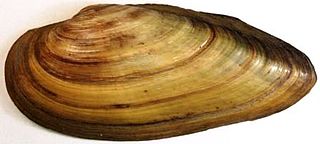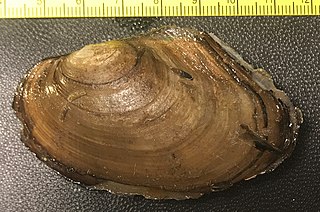The Dreissenidae are a family of small freshwater mussels, aquatic bivalve molluscs. They attach themselves to stones or to any other hard surface using a byssus. The shells of these bivalves are shaped somewhat like those of true mussels, and they also attach themselves to a hard substrate using a byssus, however this group is not at all closely related to true mussels, being more closely related to the venus clams (Veneridae).

The Unionidae are a family of freshwater mussels, the largest in the order Unionida, the bivalve molluscs sometimes known as river mussels, or simply as unionids.

The depressed river mussel or compressed river mussel, Pseudanodonta complanata, is a species of freshwater mussel, an aquatic bivalve mollusk in the family Unionidae, the river mussels. The species name comes from the flattened shape of its shell.

Unio crassus, the thick shelled river mussel, is a species of freshwater mussel, an aquatic bivalve mollusk in the family Unionidae, the river mussels.

Unio is a genus of medium-sized freshwater mussels, aquatic bivalve mollusks in the family Unionidae, the river mussels. They are found throughout Europe, Africa, and the Middle East, with some species introduced to East Asia. Fossil species are also known from the Jurassic of North America.

Anodonta is a genus of freshwater mussels in the family Unionidae, the river mussels.

The duck mussel is a species of freshwater mussel, an aquatic bivalve mollusk in the family Unionidae, the river mussels.

The swan mussel, Anodonta cygnea, is a large species of freshwater mussel, an aquatic bivalve mollusc in the family Unionidae, the river mussels.

Sinanodonta woodiana, the Chinese pond mussel, Eastern Asiatic freshwater clam or swan-mussel, is a species of freshwater mussel, an aquatic bivalve mollusk in the family Unionidae, the river mussels.
Fluvidona anodonta or more commonly known as the North Pine River freshwater snail is a species of minute freshwater snail that is endemic to Australia. Originally discovered in 1892 by Hedley & Musson, the snail is highly elusive and only has been sighted four times since its discovery. The snail is 2 mm long and 1 mm wide with the shell colouring being of a yellow-whiteish shade. Fluvidona anodonta resides within the City of Moreton Bay, specifically in four river systems within the D'Aguilar National Park, Queensland. The four river systems are the South Pine River headwaters, the North Pine River headwaters, Kobble Creek and Low Branch Creek. The snail is found under deeply submerged rocks within permanent freshwater systems.
The dense hydrobe, scientific name Aphaostracon pycnum, is a species of small freshwater snails with a gill and an operculum, aquatic gastropod mollusks in the family Cochliopidae.
Lampsilis fullerkati, the Waccamaw fatmucket, is a former species of freshwater mussel, an aquatic bivalve mollusk in the family Unionidae, the river mussels. This former species is endemic to the United States. It is now considered synonymous with Lampsilis radiata.

Theliderma intermedia, the Cumberland monkeyface pearly mussel or Cumberland monkeyface, is a species of freshwater mussel in the family Unionidae, the river mussels. This aquatic bivalve mollusk is native to Tennessee and Virginia in the United States. Historically widespread in the upper Tennessee River system, it populations have been reduced by habitat destruction and pollution. It now only occurs in two tributaries: the Duck and Powell Rivers. It is a federally listed endangered species.

Anodonta cataracta, now Pyganodon cataracta, is a species of large freshwater mussel, an aquatic bivalve mollusc in the family Unionidae, the river mussels. Its common name is the eastern floater.
Hyridella glenelgensis, also known as the Glenelg freshwater mussel or Glenelg River mussel, is a species of freshwater mussel, an aquatic bivalve mollusc in the family Unionidae, the river mussels.

Anodonta californiensis, the California floater, is a species of freshwater mussel, an aquatic bivalve mollusk in the family Unionidae, the river mussels.

The winged floater is a species of freshwater mussel, an aquatic bivalve mollusk.

Ambleminae is a subfamily of freshwater mussel in the family Unionidae. They are found throughout much of eastern North America south to Central America, although fossils are also known from Siberia. Some species have also been introduced to East Asia. They are the most speciose radiation of the Unionidae, with more than 300 species.











